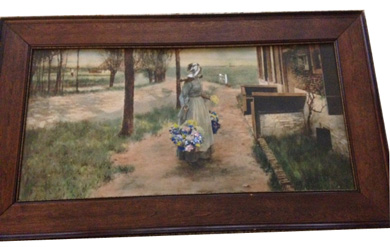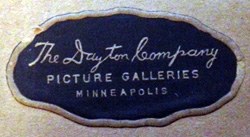 |
|
|||
 |
 |
|||
Copyright © Harry Rinker, LLC 2015 Questions
and Answers
QUESTION: I have a framed print of a painting by George Hitchcock that features a Dutch girl selling flowers at home along a canal. It belonged to my grandmother who lived in Minneapolis. She would be either 109 or 110 if she were alive today. The back of the picture has an oval label that reads: “The Dayton Company / Picture Galleries / Minneapolis.” I am guessing the picture could be as old as the 1910s. Unfortunately, the glass recently broke during a recent move. Is it worth my effort to attempt to determine the value of the print? – DH, Email Question
ANSWER: The print has a family value that transcends its secondary market value. Learning more about the print and its value is worthwhile for this reason alone. George Draper Dayton became a partner in Minneapolis’s R. S. Goodfellow Company, doing business as Goodfellow and Eastman, in 1902. By 1903, Dayton bought out his remaining two partners and renamed the store Dayton’s Dry Goods Company. The name was changed again in 1910 to Dayton Company. The Dayton department store chain, based in Minneapolis, became a regional power in the upper Midwest. [See: https://en.wikipedia.org/wiki/Dayton%27s] [TRIVIA QUESTION: This is a two-part question. First, what toy did Dayton’s introduce in 1949 that became a Baby Boomer favorite? Second, what national Big Box store chain did Dayton originate?]
George Hitchcock (1850-1913), was an American artist, who spent most of his artistic life in the Netherlands. After graduating from Brown University and Harvard Law School, he traveled to Paris to study art under Gustave Boulanger and Jules-Joseph Lefebvre at the Acadèmie Julian. He established a studio near Egmond aan Zee in the Netherlands. Through is “Art Summer School,” he created a group of artists known as the “Egmondse School” (1890-1905). [See: https://en.wikipedia.org/wiki/ George_Hitchcock_%28artist%29] Hitchcock’s work is featured in the collections of a number of art galleries including Chicago Art Institute, Detroit Institute of Arts, Dresden, and the imperial collection in Vienna. The broken glass provides an opportunity to enhance the matting of your print. Chances are the back mat is not acid free. Replace it with acid free (museum board) mat. The photograph that accompanied your query suggests the print is touching the glass. Have the frame shop cut a thin piece of mat to be placed in the rabbit of the frame so that when remounted, the print no longer touches the glass surface. There is no reason to use other than regular glass. A word of caution: I recently replaced the glass in two large framed prints that had been broken during Linda’s and my move from Connecticut to Michigan. I was taken back when the cost was close to one hundred dollars for each one. The cost to replace the glass and upgrade the matting for your Hitchcock “Flower Girl in Holland” print may exceed its secondary market value. With the glass broken, someone may pay $15.00 to $20.00 for the frame. With the glass replaced and new matting, the finished piece is worth between $35.00 and $45.00, a value that is decorative rather than collector based. QUESTION: How much is a Marian Yu doll made by Marian Yu Design worth? – EM, Email Question ANSWER: I love it when an internet search leads me to a past “Rinker on Collectibles” column. This proved true for your Marian Yu doll. Column #1185 written five and one-half years ago noted: “Marian Yu dolls were sold on the Home Shopping Club cable channel in the late 1980s. They were touted as ‘heirloom dolls,’ a do-not-waste-your money promotional trigger to any knowledgeable collectibles buyer. Most dolls were sold in numbered editions of 2,000. This explains the numbers of your dolls. Costumes varied from Victorian to Country informal. Rinker’s Thirty Year Rule applies—“For the first thirty years of anything’s life, all its value is speculative.” Buying any designer doll on a home shopping channel is speculative. Few increase in value over time. Most sell on the secondary market for pennies on the initial purchase dollar.” When ROC #1185 was published, internet dealers listed dolls between $50.00 and $65.00, with some private individuals offering them between $45.00 and $50.00. Today, a doll collector can buy all the Marian Yu dolls that he/she wants for under $15.00 if willing to comparison shop. If encountered at auction, the hammer price for a Marian Yu doll is less. What is fun are the prices being asked by sellers who are members of “there is a sucker born every minute” club. One seller was asking over $300.00, a far cry even from the $45.00 to $60.00 per doll eternally-optimistic crowd. My final advice is the same as it was over five and one-half years ago. “Your doll has more play than display value. It has no long-term collectability. Pass it along to a grandchild or favorite niece who will hug and hold it.” QUESTION: I am a subscriber to Yesteryear. I have written to three different columnists over the years seeking an answer to my question and have never received a reply. I have a spoon that has a Bakelite bowl with a silver handle. “H. BEAGUE / Francis De Grave & Cla Street / Lille” is printed on the inside of the cover of the latched, fitted, velveteen covered case. What do I have? – PK, Sun Praire, WI ANSWER: First, the name inside the cover of the box is that of the jewelry/gift store that sold the spoon. Since Lille is in the northeastern portion of France near the Belgium border, it is impossible to determine the manufacturing origins of your spoon without knowing what hallmarks, if any, are on the handle. The spoon is a presentation gift, most likely dating from the first two decades of the twentieth century, a time when such items were common for anniversary and special occasion gifts. Normally, the initials of the recipient would be engraved on the handle. The pictures which accompanied your letter were out of focus. Hence, I was not able to see the spoon’s details. Also missing was the size, albeit judging from the box, the spoon is the size of a serving spoon. American collector interest in this type of spoon is minimal. No one is going to use or display it. Its American secondary market value, unless in a large urban area, is under $50.00. Europe is another matter. Europeans love these spoons. In an antique shop in one of the Euro countries, the spoon would easily command 100 Euros.
ANSWER: In Upton Sinclair’s 1906 novel “The Jungle,” Sinclair attributed the quote “everything but the squeal” to the meat-packing industry. Armour & Company followed that principle. Philip D. Armour partnered with John Plankinton of Layton and Plankinton Packing Company in 1863 to establish Amour and Co. Headquartered in Milwaukee, the company quickly established Chicago and Kansas City branches and a New York City export operation. According to Wikipedia [https://en.wikipedia.org/wiki/Armour_and_Company], “in its early years, Armour sold every kind of consumer product made from animals: not only meats but also glue, oil, fertilizer, hairbrushes, buttons, oleomargarine, and drugs made from slaughterhouse byproducts.” Armor Pharmaceuticals most likely produced your tin of benzoinated lard, which was used as an illuminant, lubricant, oiling wood, and manufacturing soap. Benzoinated lard contains 1 percent benzoin. It served as a base for topically applied medicines. Greyhound, who acquired Armour and Company in 1970, sold Armour Pharmaceuticals to Revlon in 1978. Avon spun off the drug unit and sold it to Rorer in 1985. Forest Laboratories purchased the rights to Armour products in 1991. Some pharmaceutical assets transferred to CSL Behring. The can’s rough condition raises concern about the possible eventual leakage of the lard. At best you have a curiosity item. Any secondary market sale above a dollar or two makes you a winner. My suggestion is to junk it and try to find your profit in the other objects that were part of the box lot that you purchased. Even in great condition, the can of Armour & Company benzoinated lard is worth less than $10.00. TRIVIA QUESTION ANSWERS: (1) “Cootie” developed by Milwaukee postman, fisherman, and toy maker William “Herb” Schaper; (2) Target.Harry L. Rinker welcomes questions from readers about
collectibles, those mass-produced items from the twentieth and twenty-first centuries.
Selected letters will be answered in this column.
Harry cannot provide personal answers.
Photos and other material submitted cannot be
returned.
Send your questions to: Rinker on Collectibles, 5955 Mill
Point Court SE, Kentwood, MI 49512.
You also can e-mail your questions to
harrylrinker@aol.com.
Only e-mails containing a full name and mailing address
will be considered.
You can listen
and participate in
WHATCHA GOT?, Harry’s
antiques and collectibles radio call-in show, on Sunday mornings between 8:00 AM
and 10:00 AM Eastern Time.
If you
cannot find it on a station in your area,
WHATCHA GOT?
streams live on the Internet at www.gcnlive.com.
SELL, KEEP OR TOSS?: HOW TO DOWNSIZE A HOME,
SETTLE AN ESTATE, AND APPRAISE PERSONAL PROPERTY
(House of Collectibles, an imprint of Random House Information Group, $17.99),
Harry’s latest book, is available at your favorite bookstore and via
www.harryrinker.com.
|
||||

 Like many department stores of its time, Dayton had a department that sold household decorative prints. The prints were obtained from stock houses. The stock frames were standard sizes, designed to match the stock house print sizes. Your print dates from the 1910s, my dating being based on the style of the frame. The print most likely remained in the stock house inventory through the 1930s. I have seen the image on 1920s and 1930s calendars and jigsaw puzzles.The print’s romantic imagery is timeless.
Like many department stores of its time, Dayton had a department that sold household decorative prints. The prints were obtained from stock houses. The stock frames were standard sizes, designed to match the stock house print sizes. Your print dates from the 1910s, my dating being based on the style of the frame. The print most likely remained in the stock house inventory through the 1930s. I have seen the image on 1920s and 1930s calendars and jigsaw puzzles.The print’s romantic imagery is timeless. QUESTION: In a recent box lot at auction I acquired a one pound tin of benzoinated lard prepared at the laboratory of Armour & Company, Chicago. It is not in the best of shape. A quick online search netted nothing. What can you tell me about it? – LH, State College, PA, Email Question
QUESTION: In a recent box lot at auction I acquired a one pound tin of benzoinated lard prepared at the laboratory of Armour & Company, Chicago. It is not in the best of shape. A quick online search netted nothing. What can you tell me about it? – LH, State College, PA, Email Question